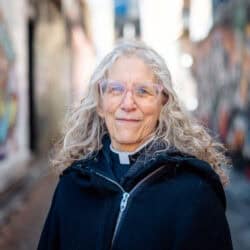A true pandemic recovery must include a mental health recovery plan, particularly for the hardest-hit marginalized youth. The In This Together campaign is working to make that plan a reality.
After only a few months of lockdown, back during the first pandemic summer, Abrar Mechmechia was already worrying about COVID-19’s long-term impact on mental health: the effects of isolation on the psyche, the lack of support networks, especially for marginalized youth. There are plenty of crisis lines, but in a time of crisis is that enough, wondered the 27-year-old certified mental health counsellor and the founder of ABRAR trauma and mental health services.
“I had the idea to start a support group for youth as early intervention for BIPOC youth, refugees, and newcomers, who have been going through a tough time due to the pandemic,” says Mechmechia, reckoning that there had to be a better way forward.
She had lived in Aleppo when the Syrian civil war began. “As a teenager I lived in a war zone, as a young person I worked on the ground providing mental health care,” Mechmechia, who is now based in Hamilton, wrote in a press release. “Today as a young person now in Canada during the pandemic I understand that each of our experiences will be different, but I don’t want any youth to feel the same way that I did.”
She shared her idea about a support group with Rabia Ahmed, who studied mental health and biology at the University of Toronto and had been introduced to Mechmechia through a mutual acquaintance, and Ammani Hanafe, a friend who is a youth advocate. Ahmed and Hanafe volunteered to work with Mechmechia, and they were able to secure enough funding to launch a group in November 2020.
The idea was first to raise awareness about COVID-19’s impact on marginalized youth. Two, to start a conversation [about co-creating] with youth themselves a mental health recovery plan. Also, to highlight the importance of an early-intervention approach during the pandemic.
Abrar Mechmechia
The need was “huge,” Mechmechia says. So much so that she launched a campaign in February 2021, calling on the Canadian government to include a mental health recovery plan with youth input in its bid to “build back better” as it worked to adjust to the pandemic. As it happens, mental health issues became an election issue, with several parties including mental health service reforms in their platforms.
“The idea behind the campaign was first to raise awareness about the impact that COVID-19 had on marginalized youth. Two, to start a conversation toward coming together to co-create with youth themselves this pandemic’s mental health recovery plan,” Mechmechia says. “Also, to highlight the importance of an early-intervention approach during the pandemic.”
And thus, In This Together was born, a campaign that has so far included an open letter to federal and provincial leaders, research on the effects of the pandemic on marginalized youths’ mental health, and a two-day conference supported by the Laidlaw Foundation – all made possible with the help of many volunteers, including strategic advisor Irwin Elman and content advisor and research supervisor Omar Reda. (Elman is a fellow at the Laidlaw Foundation, which provided some funding for one of Abrar’s events, along with other backers, including Justice for Children and Youth.)
In This Together’s research findings
The In This Together research team, co-led by Ahmed and Hanafe, surveyed youth across Canada between the ages of 15 and 29 with the goal of better understanding mental health service gaps and helping to shape suggestions for a post-pandemic mental health recovery plan. The hope is that this research will serve as evidence for the importance of such a plan.
Eighty percent of those surveyed said their mental health had worsened since March 2020, when the pandemic and its lockdowns started, and 66% attributed mental health challenges directly to the pandemic. More than 90% reported feelings of isolation, fatigue, loneliness, and lack of motivation. Ahmed – who is also a patient, resident, and family facilitator with Unity Health Toronto – observed that most of the self-reported symptoms resemble depression.
“I think this will have significant long-term impacts because individuals have been experiencing these symptoms for quite a long duration,” Ahmed says. “We need to be aware that the habits that were formed during the last year will be difficult to change, and we need to allow people, and especially youth, the time they need to transition and adjust to new routines and procedures.”
If people are really trying hard to get support and the support they are getting is not meeting their needs, what is wrong?
Abrar Mechmechia
The key findings showed that the main issues faced by the youth interviewed were inaccessibility, ineffective treatment, financial barriers, stigma, lack of cultural competency, and the need for more academic support.
“The financial barrier was expected, especially when it comes to marginalized populations. But ineffective treatment? That does break your heart. If people are really trying hard to get support and the support they are getting is not meeting their needs, what is wrong?” says Mechmechia.
Hearing from youth directly
At the In This Together conference, one panel featured marginalized youth who have firsthand experience with mental health services in Canada and have dealt with mental health problems. Their conversation corroborated the main points from the research, especially with regard to how a lack of cultural competence from health service workers can lead to ineffective care.
“I believe that true healing and the best practices for many Indigenous Peoples is practising their own culture and having access to go back to our communities, which were restricted for a very long time [due to the lockdowns],” says Marshall Morrisseau, a member of the Métis Nation and an Indigenous youth advocate. “If we want to approach healthcare and health services with an Indigenous perspective, we need to start bringing in those traditional knowledge holders and keepers and have them integrate those practices.”
Non-marginalized mental health professionals seem to have a very narrow view of what is considered trauma.
Hel Kevorkian
Furthermore, when healthcare workers are not attuned to what marginalized youth are going through, those healthcare workers leave out how COVID-19 compounded existing ongoing issues – such as intergenerational trauma, racism, Islamophobia, and antisemitism, to name a few – says Hel Kevorkian, a Syrian refugee and University of Toronto at Scarborough student who struggles with bipolar disorder and has developed PTSD and addiction as a result of repeated trauma.
“Particularly, non-marginalized mental health professionals seem to have a very narrow view of what is considered trauma,” says Kevorkian. “They tend to focus on significant events such as major physical assault. By excluding these repetitive long-term traumas, we actually just further invalidate the experiences of marginalized youth and are just perpetuating health disparities.”
There are a lot of traumas that can be related to your culture, to being a queer youth, and a lot of this isn’t really addressed if all the people going into the field are cis, abled, and white.
Steffi Arkilander
Steffi Arkilander, who recently graduated from McMaster University’s health sciences program, would like to see more diverse students encouraged to join the mental health field.
“Personally, I’m Chinese and bisexual, and I’ve never had a racialized therapist to talk to,” says Arkilander. “There are a lot of traumas that can be related to your culture, to being a queer youth, and a lot of this isn’t really addressed if all the people going into the field are cis, abled, and white.”
Shabnam Mahboobi, an Afghan Canadian mental health advocate and poet, points to how she was unable to speak her mind when she was younger, often because of trauma and cultural stigma around depression. “Mental health education and coping tools – all of these things need to be introduced at a much younger age in order to have a long-term positive benefit in the lives of future Canadians,” especially for newcomer youth, she says.
What organizations can do
Mechmechia notes that the concerns brought forward by the In This Together research are not new, but she hopes that qualitative and quantitative data will help organizations and government stakeholders come together more effectively to develop a tangible action plan that prioritizes the needs of marginalized youth.
Demand for services increased notably during the pandemic. The Refugee Centre in Montreal, a non-profit organization that focuses on building and providing a sustainable structure of integration for newcomers and refugees in Canada, created a wellness program in October 2020 to address increased mental health needs. Kids Help Phone, a 24/7 national support service, saw a 112% increase in calls between March 2020 and March 2021, and they nearly doubled their staff in response.
As part of Kids Help Phone’s pandemic response, for example, the organization partnered with Stepped Care Solutions and Homewood Health, with support from Greenspace Health, to launch Wellness Together Canada.
Wellness Together offers a range of services, “from immediate crisis support to mental health screening and self-assessment tools, peer-to-peer support, educational resources, e-courses, access to virtual cognitive behavioural therapy, and access to counselling support by phone, text, or live chat,” explains Ravina Anthony, project manager of newcomer and diversity initiatives at Kids Help Phone.
‘Why do I have to wait until I am in crisis?’ That is something I heard a lot from the youth that we were working with.
Abrar Mechmechia
Such support that focuses on a range of interventions – giving people what they want when they need it, and from the organization and people they want to receive it from – is crucial to effectively addressing how we respond to crises like the pandemic. It’s important that people have access to effective, less-intensive care if that’s what they need, leaving more specialized, intensive resources for when it’s necessary – rather than offering crisis hotlines as the only solution. “‘Why do I have to wait until I am in crisis?’ That is something I heard a lot from the youth that we were working with,” says Mechmechia.
Jude Ibrahim is the mental health coordinator at The Refugee Centre in Montreal. She attended the In This Together conference because The Refugee Centre wanted to hear from youth directly about what steps to take as an organization.
“COVID-19 had a big impact, and it changed the ways we do our services – it impacted youth in various ways,” says Ibrahim. “It added another barrier that we have to acknowledge. Listening to how other organizations overcame these barriers was a learning point for our organization.”
Ibrahim believes that recovery will have to be approached from communal, individual, and organizational levels. She notes that collaboration is integral to The Refugee Centre’s work, as they strive to make services easily accessible to refugees without adding more obstacles to the immigration process. “What we really do is we collaborate with different organizations and different mental-health-care agencies to find ways where we can be a liaison to refer them and also overcome that sense of long wait lists.”
Clearly, collaboration is key. One institutional barrier the In This Together campaign hopes to highlight is the uneven distribution of resources. While larger mental health organizations have more resources, grassroots organizations often have closer ties to specific communities. The team hopes that the campaign encourages everyone to come together to fill in service gaps.
“For example, each organization will do something under the umbrella or under this program of healing or a post-pandemic recovery plan, but they do one program or one workshop or one discussion,” says Mechmechia. “For the most part, it is divided efforts; it is not collective effort, and that is what I hope to see.”
What are governments and the charitable sector doing to support young people?
Recognizing that students this fall will have experienced different levels of negative impact because of the pandemic, provincial ministries are investing money into mental health, and school divisions and boards across the country are preparing varying supports. Many have also acknowledged the need for culturally appropriate responses to mental health and are working to address needs before they escalate into crisis.
For example, British Columbia was uniquely able to keep in-person schools running for the 2020/21 school year. The Ministry of Education proactively created a Mental Health in Schools plan back in September 2020, which will guide the Mental Health School Start-Up Working Group they’ve established to review available information on what needs to happen in the 2021/22 school year.
In Toronto, which had one of the world’s longest lockdowns, Toronto District School Board spokesperson Ryan Bird explains that teaching staff receive ongoing training in mental health. “Providing more [professional support services] for communities most impacted by the pandemic will also occur,” Bird says.
It is important to provide the programs and resources that are easily accessible to the classroom, community, and caregivers.
Julie Millar
The Winnipeg School Division has been working on a mental health strategy called Healthy Minds since 2013, long before the pandemic. “Manitoba has the highest rate of suicide among youth in Canada, and it is incumbent upon us to ensure our staff are suicide-alert at all times, but definitely post-pandemic,” says Julie Millar, the division’s director of student services. “It is important to provide the programs and resources that are easily accessible to the classroom, community, and caregivers.”
Despite partnerships across the board in schools with different organizations, the closest thing Canada has to the mental health recovery plan that Mechmechia’s team wants to see seems to be the COVID-19 and Mental Health Initiative, which the Canadian Institutes of Health Research, the federal agency for funding health research, launched last year to fund research during COVID-19 on mental health and substance use.
Mechmechia points to New Zealand’s plan as a possible model. Its COVID-19 mental well-being plan was updated in December 2020 with changes such as making sure the strategy was more in line with the five-year Māori Health Action Plan.
New Zealand’s framework looks at how, in 12 to 18 months from when the framework was published, the government plans to help people maintain their well-being and cope with the pandemic – especially through community-led solutions. Notably, the plan prioritizes Māori health and equity.
YMCA Canada in mid-August added its voice to the discussion, with a report, entitled Preventing a Lockdown Generation, that recommends a six-pronged approach the federal government should adopt to tackle the crisis of youth mental health.
Mechmechia still hopes to see Canada do something similar and plans to launch In This Together as a non-profit in 2021. “When you grow up in a war zone, you see how important it is for people to really come together in hard times and think about the community as a whole and not think about themselves individually – to be able to heal,” she says. “I don’t see Canada healing from this or recovering from this quickly, and if we don’t put the right effort in collectively, it will take longer than we expect.”
If you or someone you know needs emergency mental health support, contact:
- Canada Suicide Prevention Service (for anyone) at 1-833-456-4566
- Hope for Wellness (for all Indigenous Peoples) at https://www.hopeforwellness.ca/ or at 1-855-242-3310
- Kids Help Phone (for anyone aged 5 to 29) at https://kidshelpphone.ca/live-chat/ or text “CONNECT” to 686868


